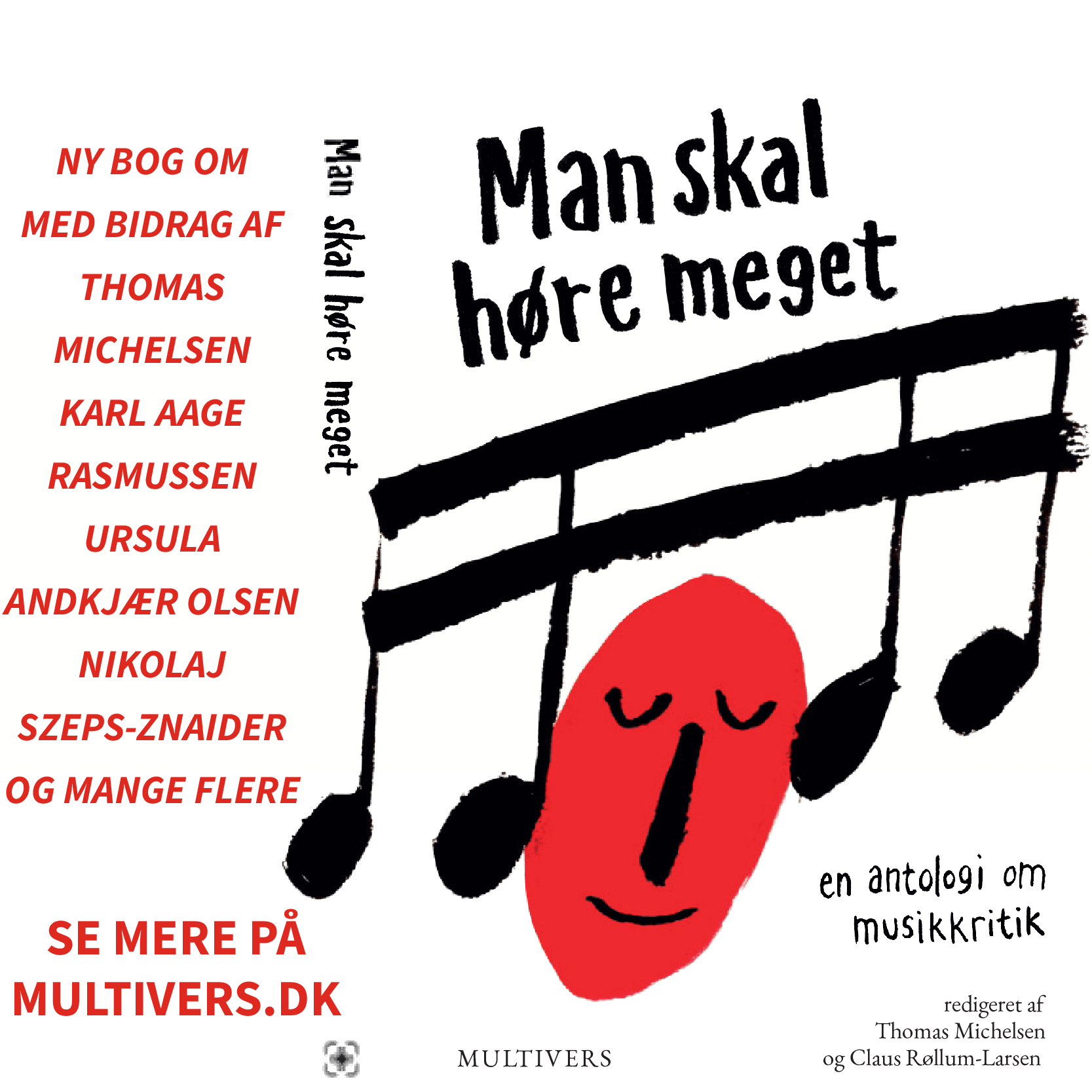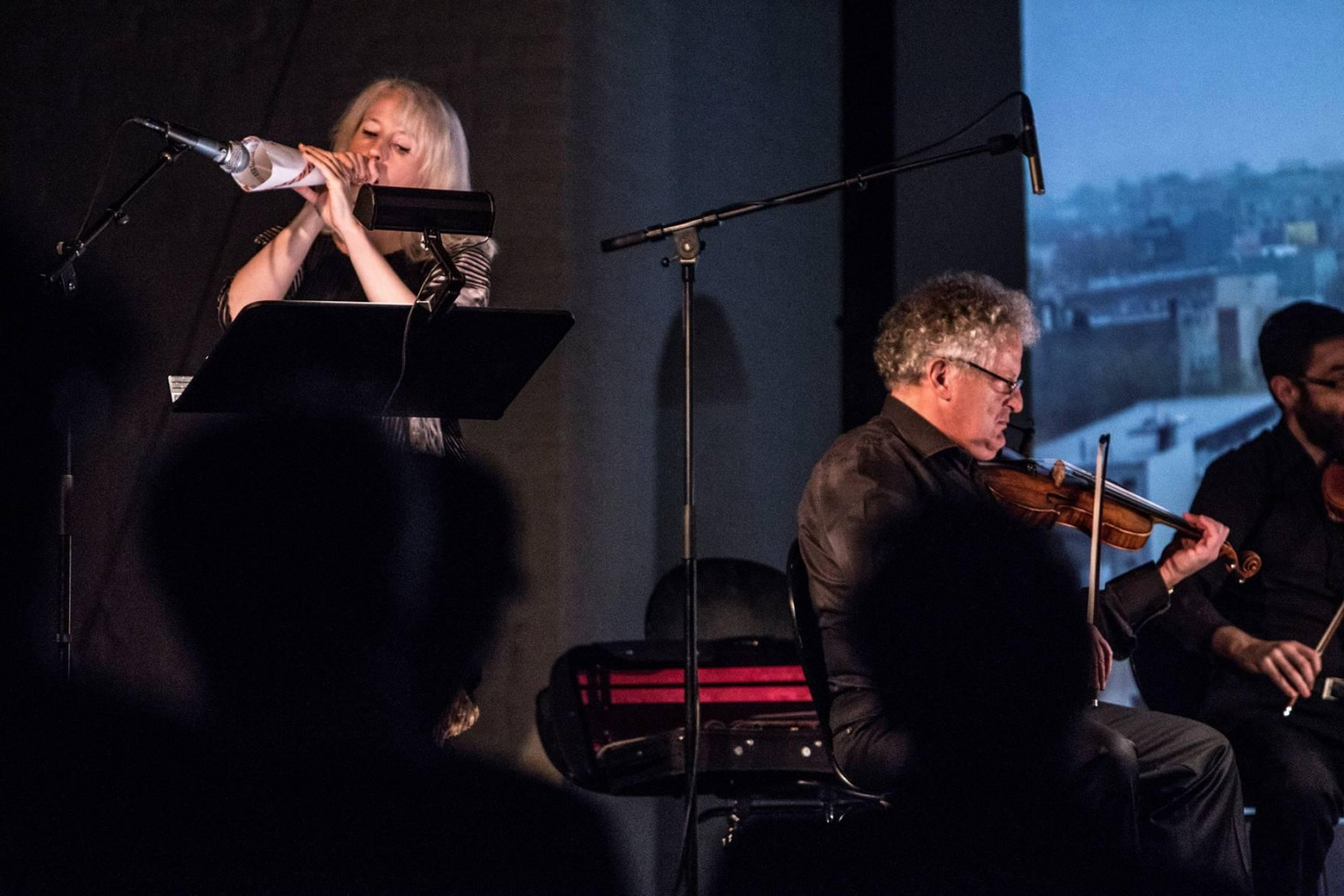
Gong Tomorrow
The centerpiece of Gong Tomorrow’s opening concert was a performance of John Cage’s Four (1989) from the Arditti String Quartet. There was a well-known philosopher sat directly in front of me at Koncertkirken who fell asleep a number of times during the performance.
He wasn’t falling asleep in spite of the music. He was falling asleep with it – juddering upwards at Cage’s paragraph breaks before beginning another slow, lurching, angular descent onto the shoulder of the man sat next to him (the artistic director of a different contemporary music festival). But at least once, the long lines of Four couldn’t induce the philosopher to resurrect of his own accord. The artistic director had little choice but to let his snoozing companion’s bulk come to a rest on his own upper arm and shoulder, momentarily acclimatizing himself to the new and slightly awkward feel of it.
They never warm up and they don’t really coalesce, but they do invite you in
Eventually, wouldn’t that awkwardness give way to the actual, physical warmth of two bodies maintaining physical contact? Likewise, it’s striking how cold and, yes, awkward Cage’s Four can appear at first: a string quartet playing with little or no vibrato, each instrument offering pure, consistent notes in what feels like a series of independent monologues rather than a conversation. At first, the result of this mustering of notes isn’t really anything like harmony; the quartet isn’t playing ‘chords’. That’s the wonder of Cage’s entire project. But soon, like those two men unwittingly joined together, Cage’s handful of delicately spun notes settle into a sort of tectonic balance. They never warm up and they don’t really coalesce, but they do invite you in. And once you’re in, you’re in – under the surface, between the sheets.
The Arditti String Quartet’s performance had a radiant poise and patience, which probably helped induce the philosopher’s slumber. But the performance was also looser than it was tight, just as it needed to be, delivering a ‘removed’ sound (in the context of what we know about quartet playing) that asks some interesting questions about the whole process of ensemble performance. If there was one message that 2016’s Gong Tomorrow appeared to communicate – across the three concerts I attended, at least – it was that the idea of an ‘ensemble’ and ‘ensemble playing’ in this still new century is potentially be far less concerned with traditional musical tension than we think. Is the idea of ‘an ensemble’ a red herring in the first place?
Maybe we sensed that so acutely in the Arditti String Quartet’s performance of Four because the piece that came before it was wracked with such traditional tension (and was not unconcerned with counterpoint) despite its experimentalist garb. Nicolai Worsaae’s Squawk (2016) – a piece for string quartet, video and live electronics – often used cells of equal-length notes that twisted around themselves like miniaturized images of peeling church bells.
Worsaae knew what he was doing
That created a certain yet inconsistent rhythm in the ‘quartet’ elements of the piece, but when those sounds combined with the sampled noises (scrapes, squawks, fragments of radio transmissions from the Apollo space project) the music settled into something like a natural, consistent flow – a polyphonic weave. The Arditti String Quartet – tight in the gossamer-thin but never quite pitch-less sounds that Worsaae scored for them – sat behind a white screen onto which film footage was projected. Among the fragmentary images was one of a traditional, ball-gowned string quartet playing rhapsodically on an ornate stage. Worsaae knew what he was doing.
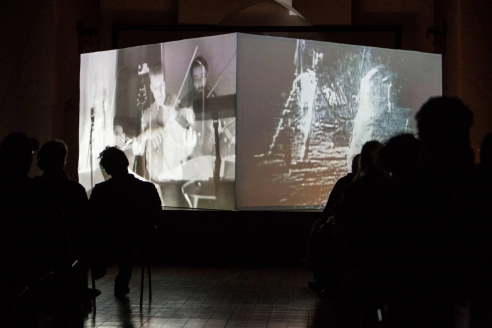 Nicolai Worsaae’s 'Squawk' performed by Arditti Quartet. Foto: Lars Bjarnø.
Nicolai Worsaae’s 'Squawk' performed by Arditti Quartet. Foto: Lars Bjarnø.
But it was difficult to sense, in Worsaae’s piece, the seismic implications inherent in the works that followed it. How good it is to be reminded, for example, that however much John Cage examines basic, physical, primordial sound possibilities in music, his pieces usually create a space for the audience – whether purposefully or not. After Four, Jennifer Walshe joined the Arditti String Quartet for a performance of her own work Everything is Important (2016), premiered at Darmstadt on 2 August and appearing at new music festivals throughout northern Europe right now.
The piece was a deranged and brilliant gesamtkunstwerk – a spluttering, ranting, psychotic string of verbal vernaculars spat out by Walshe herself (when she wasn’t breathing, sucking and laughing manically) while the Arditti String Quartet scraped complicit underneath and an endless Harry Hill-style parade of disjointed words and images trailed over the top. In this piece, nothing lasts; everything appears to drift into mania or meaninglessness (or a ponderous catch-phrase; ‘Am I right ladies?’) before it can muster any conceptual traction. Every time Walshe poses a big question she spikes it with some clanging millennial banality (‘the problem of existence LOL’).
Even as Walshe tore affectionately into the overload and isolation of the internet age, there were those in the audience Tweeting and Instagramming
It’s rare to come across a scored piece of music theatre that, even momentarily, appears to consign almost every comparable effort to a past age. Even as Walshe tore affectionately into the overload and isolation of the internet age, there were those in the audience Tweeting and Instagramming. That was fine; Walshe wasn’t really accusing, and the delightful chaos of her ideas in this piece – maybe a strange, distant descendent of the particle-accelerator opening to Carl Nielsen’s Third Symphony – ultimately alighted upon more gregarious, less accusatory sentiments: a focus on living rather than capturing (as in the sequence during which Walshe hits play on some 90s pop and dances with self absorption in the corner).
It’s hard to intelligently cite structural pivots or transformative moments across the sprawling form of Everything Is Important, so in the tradition of cutting, pasting and sharing on which she has so much to say, I’ll pick out two faves: the extraordinary, virtuosic sequence in which Walshe spewed out fragments of the phrase ‘she’s on the internet’ (the human equivalent to that spiral of self-perpetuating error messages) and her scoring of what sounded like an Elizabethan viol consort for the quartet – something like a slow movement over which Walshe sang a veiled vocal that appeared to drift in an out of a counterpoint with the instruments.
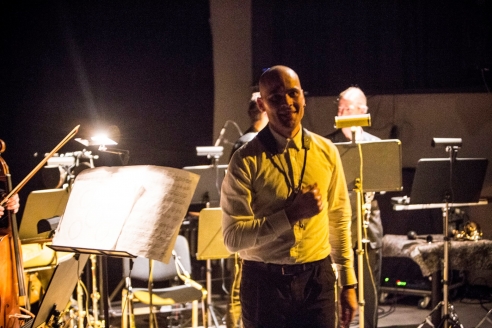 Johs Lund's piece '28' performed by the composer himself and Ekkozone. Foto: Lars Bjarnø.
Johs Lund's piece '28' performed by the composer himself and Ekkozone. Foto: Lars Bjarnø.
How do you follow a piece like that? You could do a lot worse than follow it with 28 (2016) by Johs Lund, which opened Ekkozone’s concert at Christiansavns Beboerhus five days later and whose notes were the first at Gong Tomorrow I heard after Walshe’s. In a sense, this piece was a stream of consciousness too. But that consciousness was drilled deep – reigned-in but potentially hugely expansive, a little like those acute, narrow trains of thought that lock you in after a strong joint.
Gong Tomorrow once more underscored its programming acumen by shunting 28 up against two works by the late Pelle Gudmundsen-Holmgreen that do the direct opposite
Lund’s instruments (violin, cello, clarinets, saxophone – instructed by signals from tuned percussion) engaged in their own little limited cyclic patterns that create a beautiful, random, gentle polyphonic grind against each other. Texturally, the sound put me in mind of the barrel organ effect in Alban Berg’s Lulu. Speaking of which, the simple technical devices employed by Lund were akin to a loom producing a constant weave of transforming colours. In terms of ‘ensemble’ (or lack of it), the piece’s random contrapuntal flow recalled the strings of Cage’s Four – instruments interested not so much in cozying up to one another, as standing apart and observing what sort of pattern their individual monologues might form when combined, as if projections on some distant wall.
In that sense, this was music that looked far beyond itself and whose untouchable industrial spool delivered an unlikely, purifying charm. Like the wool that feeds the loom, Lund’s instruments simply kept going, obeying the rules, until they ran out of notes. Gong Tomorrow once more underscored its programming acumen by shunting 28 up against two works by the late Pelle Gudmundsen-Holmgreen that do the direct opposite: the composer’s old but still so fertile trick of urging instruments to find a way of getting along – the more unlikely that outcome, the more interesting the piece.
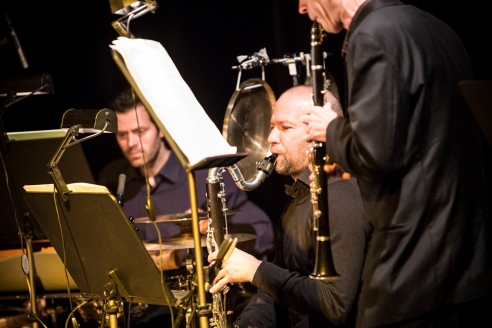 Ekkozone performs Pelle Gudmundsen-Holmgreen's 'Body and soul'. Foto: Lars Bjarnø.
Ekkozone performs Pelle Gudmundsen-Holmgreen's 'Body and soul'. Foto: Lars Bjarnø.
To being with, PGH’s classic Plateux pour Deux (1970) was given a new twist as Mathias Reumert played-up the theatre of his squeeze-bulb traffic horns, trying so hard to find some way of getting through to John Ehde’s cello (perhaps this is why they were positioned so far apart on the stage; either that or Ehde didn’t feel like moving his chair after Lund’s 28). The sweet, sad message of the piece, perhaps, is that after all the percussionist’s efforts to persuade the cello into confidence and speech, the cellist has nothing much to say; the counterpoint that could have existed has been squandered, and not because it wasn’t viable. Reumert’s theatrics trod a fine line and could have trampled on that idea but ultimately the performance semaphored PGH’s touching little message in a way that was unusually moving. I’m not sure I’ve heard such a railing, persuasive argument against human loneliness since Leoncavallo’s L’amico Fritz from Den Jyske Opera last year.
And then, musically, PGH does what Cage does: asks us, openly, what counterpoint (and therefore ‘ensemble’) really is.
And then, musically, PGH does what Cage does: asks us, openly, what counterpoint (and therefore ‘ensemble’) really is. Agreeing to disagree? Some sort of ritual thematic spooning? Or the residual music that emerges when two musical threads, however different, are forced together and must – like the philosopher and the artistic director – share the same space, however briefly?
That idea comes to maturity in PGH’s Body and Soul (2011). Here, that symbiosis of instruments – the tightest sort of ensemble imaginable – manifests itself best as the second movement shuffles along with the sure but lopsided gait of some multi-legged animal, instruments disguised as fur, limbs, tail, eyes. As in Bach, you feel the pulse of the music so clearly even when no instrument is sounding on the beat or even framing it. But we felt it even more in this performance from Ekkozone, an ensemble that seems to reveal the percussion at its heart in everything it does. That made for an interesting comparison with Athelas Sinfonietta’s recent Dacapo recording of Og (2012) a score related to Body and Soul in its vomiting-up of chunks of Mozart’s Don Giovanni.
Accordingly, I’ve never heard PGH’s music sound quite so ‘traditional’, yet at the same time, perhaps I’ve come to realise that its distinct sense of iconoclasm comes absolutely from setting stuff up in direct confrontation with tradition. It doesn’t invalidate anything written above about Jennifer Walshe’s Everything is Important to admit that it, too, is a piece concerned in some sense with a commentary on tradition. But Cage, as we heard, looked at music from the other side of history. And so did Gong Tomorrow’s acoustic grand finale at Copenhagen’s Jazzhouse, Niels Lyhne Løkkegaard’s SOUND X SOUND project: an attempt ‘to reinvent the instrument from a constructive point zero’ in the composer’s words.
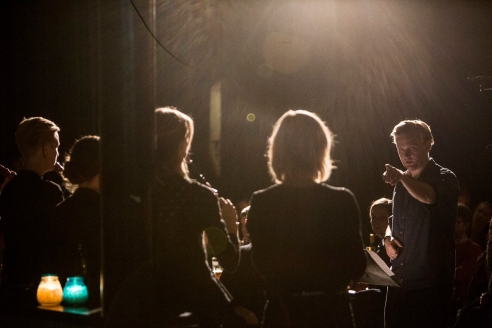 The composer Niels Lyhne Løkkegaard as conductor of his own music. Foto: Lars Bjarnø.
The composer Niels Lyhne Løkkegaard as conductor of his own music. Foto: Lars Bjarnø.
The project (I can’t think of a better word) consists of five pieces with titles that teasingly reference some of the most significant back-to-basics scores of the twentieth century: Music for 8 Recorders (2013); Music for 10 Hi-Hats (2015); Music for 30 Chromatic Tuners (2014); Music for 20 Clarinets (2015); Music for 30 Triangles (2016). Each of them treats its ‘ensemble’ as a single instrument; a picture formed from pixels.
In some sense Løkkegaard’s pictures were like those that used to adorn student dormitories in the 1990s, where if you stared long enough into the pixilated mass a new kinetic energy emerged, swaying the picture from side to side in waves or throwing up secondary images hidden to the naked eye. The constituent parts in Løkkegaard’s pieces – the pixels, the instruments – were often sonically concealed or obscured, leaving space for a new reality to take root. Maybe the ‘ensemble’ of recorders never existed in the first place.
Løkkegaard’s return to such pure sound was hypnotizing and extremely moving if you had the courage to focus on it
Løkkegaard’s return to such pure sound was hypnotizing and extremely moving if you had the courage to focus on it. But on another level, the recorders and high-hats presented good old-fashioned Nordic nature music: a canopied forest of birds from the former, a rainfall that becomes more and more intense (just when you don’t think it can) from the latter. The ritualistic performance – part Reich, part Pärt, part Parsifal (the hi-hatters appeared like an order of monks) – referenced rituals of both concert hall and church.
But there were issues nagging away at Løkkegaard’s piece, not least its debt to so many similar post-minimalist endeavors and the presumption that the composer must now reverse out of this particular technical cul-de-sac and find a entirely different path to explore.
That doesn’t change the fact that the writing in each slice of SOUND X SOUND (with the possible exception of the more incidental and sonically arid Music for 30 Chromatic Tuners) was technically very impressive. We know as much because these pieces showed their workings. And Løkkegard can work his crowd like the best of them. His little thickening-ups, his sudden collapses and silences, his strict adherence to extremely limited cells of notes and his extraordinary yet somehow totally obvious way with structure proved it. As he ‘conducted’, I sensed he was masterminding each piece’s huge roll of sound according to the response of the audience. But it may be that, like Bruckner’s, their mountainous rising and falling was pre-ordained.
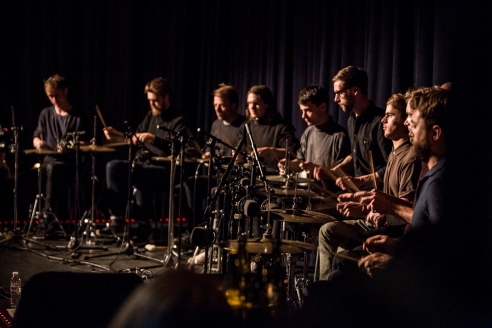 Ten drummers play music for ten high hats. Foto: Lars Bjarnø.
Ten drummers play music for ten high hats. Foto: Lars Bjarnø.
Take yet another step back, and that sense of structure appeared to work on a good number of levels – not least Løkkegaard’s alternating of pitched with non-pitched instruments and, within that, instruments with an entirely different biology to one other: the avian breath of recorders; the earthy patter of the hi-hats; the colossal subterranean congestion of twenty bass clarinets writhing low in their registers; the entirely un-natural, mechanical sound of the massed triangles. Each, of course, takes on entirely different characteristics when ‘massed’ rather that alone.
There’s no such thing as ensemble, just sounds joined by other sounds – and then abandoned by them
As it happened, the entire show ended with one man banging fiercely on a single triangle like a human fire alarm, willing us all to leave the room. The man’s once-jangling colleagues, now silent, mostly stared at their feet. Few expressed solidarity or even acknowledged that the piece was continuing. Forget that reliance we had before, they might have been saying; now you’re on your own. There’s no such thing as ensemble, just sounds joined by other sounds – and then abandoned by them. If one should lean over and rest on your shoulder, enjoy it while it lasts.
